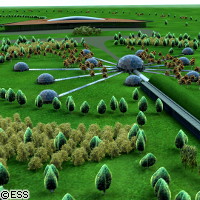Science and industry come together, the European neutron way
People need neutrons to get an inside look at what atoms are and decipher what they do. But neutrons are limited in number. The EUR 1.5 billion ESS ('European Spallation Source') project is determined to guarantee the supply of neutrons for European scientists - for now and for the future. Fast on the heels of Japan and the US, Europe is set to build its own ESS, which will help Europe maintain its foothold in the field of neutron research. Senior officials from Denmark and Sweden will address a major industrial conference on neutron research organised by the ESS project at the Royal Library in the Danish capital of Copenhagen on 19 February. Uffe Toudal, Permanent Secretary of the Danish Ministry of Science, Technology and Innovation, and Peter Honeth, State Secretary to Tobias Krantz who is the Swedish Minister of Higher Education and Research, will meet with scientists and industrialists to examine how best to strengthen ties between science and industry in Europe. The meeting is backed by the NEUTRONSOURCEESS ('European spallation neutron source (ESS)') project, also called the ESS Preparatory Phase project. Launched in April 2008 and set to end on 31 March 2010, NEUTRONSOURCEESS has received EUR 5 million under the 'Research infrastructures' programme of the EU's Seventh Framework Programme (FP7). The ESS project partners will design, construct and operate a next-generation facility for neutron research in Lund, Sweden. This ESS facility will not only foster cooperation between scientists and industrialists, but it will help quell the competition Europeans face from their Japanese and US counterparts. The scientists say it is imperative to the success of the project to find suitable industrial partners that will play a pivotal role in the facility's design, construction and operation. Experts in the fields of accelerator technology, high-precision large-scale mechanical engineering and civil engineering, to name a few, will be needed for ESS. 'We are delighted to have representatives from the Danish and Swedish government lending their support to the ESS Industry Day,' said Professor Bob Cywinski of Huddersfield University in the UK, and spokesperson for NEUTRONSOURCEESS. 'Over EUR 1 billion of contracts may soon be available for Europe-wide competitive tender. That represents a huge range of technical and commercial opportunities, and we want to ensure that we are talking to the right companies to supply the expertise that we need.' Their participation in the development of ESS will also give industrialists access to this facility. Industrial partners can use ESS to develop, refine and process technologically important materials. ESS will prove significant to myriad sectors including energy, environment and pharmacology. 'With such a broad spectrum of opportunities available it is very important that we demonstrate the enormous potential of ESS to our industrial partners now, so that as the ESS becomes operational we are able to rapidly exploit this facility for the benefit of advanced European scientific and technological industries, and of course for the European economy,' Professor Cywinski concluded. Coordinated by Paul Scherrer Institut in Switzerland, the NEUTRONSOURCEESS project brings together experts from Germany, Spain, France, Italy, Latvia, Hungary, Sweden and the UK.
Countries
Germany, Denmark, Spain, France, Hungary, Italy, Latvia, Sweden, United Kingdom



